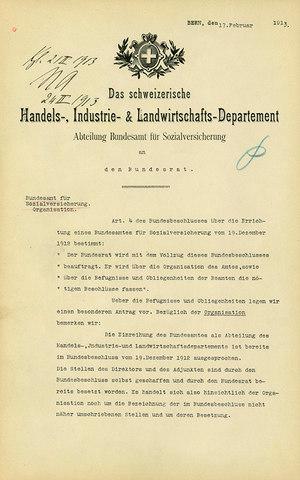
Unternavigation
Federal Social Insurance Office (BSV)
On 19th December 1912, Parliament approved the formation of the Federal Social Insurance Office (BSV). It was the first federal agency to be designated as a ‘federal office’. The BSV began its work at the beginning of 1913. It was assigned to the Federal Department of Economic Affairs until 1954 and has been part of the Federal Department of Home Affairs since 1955. Being responsible for most social security programs, the BSV is one of the most important stakeholders in social policy within the federal administration Its main task concerns preparing and implementing social legislation as well as overseeing and coordinating its social insurance programs.
The development of the BSV reflects the history of the Swiss welfare state as a whole. While it had been founded in the context of health and accident insurance, the BSV became primarily focused on planning the AHV after the First World War ended. After the ‘Lex Schulthess’ failed in 1931, the Federal Council briefly toyed with the idea of dismantling the BSV and handing its duties over to another federal office. In the end, the government decided in favor of keeping the BSV and appointed Arnold Saxer as its new director in 1938. Saxer would head the BSV until 1961 and remained a leading figure for almost a quarter of a century. During the Second World War, the BSV was attached to the Wartime Welfare Office responsible for the federal measures against poverty.
From 1942 onward and in the aftermath of the war, the Office was primarily committed to the preparation and introduction of the AHV. Soon, the income compensation scheme (EO) and family allowances in agriculture became another responsibility of the BSV. Furthermore, the BSV negotiated a range of social insurance agreements with other countries from 1949 onwards and oversaw the preparations for disability insurance, which was introduced in 1960. It also became an increasingly important representative of Switzerland in international organisations dedicated to socio-political affairs, including the International Labor Organization (IAO).
The period between 1965 and 1985 was characterized by the expansion and consolidation of old age provision, the implementation of the three-pillar model (1972), the introduction of mandatory occupational old age provision (1985), the reorganization of accident insurance (1984), as well as failed health insurance reforms (1974 and 1987). Since 1990, the FSIO has been involved in important reforms: the Introduction of Compulsory Health Insurance (1994), ), the 10th AHV Revision with independent pension entitlement for women (1997), the Introduction of Maternity Insurance (2005), the Harmonisation of Family Allowances (2006) and Consolidation (2006) as well as the Further Development of Disability Insurance (2021).
The gradual expansion of the scope of its responsibilities meant that the number of BSV employees steadily increased. While only 20 people worked in the department in 1938, fifty years later its staff encompassed 218 employees, including 67 women. Today (2024), a good 340 people work at the FSIO (61 per cent women and 39 per cent men). The offices that accommodated the BSV likewise changed and had to be expanded over time: in 1913, the department was provisionally housed in the National Bank building in Bern, before being relocated to the ‘Bund-Haus’ (or ‘federal building’) on Effingerstrasse from 1915 to 1924. Following a short interlude on Bundesgasse within the premises of the Federal Office for Industry, Trade and Labour, the BSV set up its offices on 33 Effingerstrasse in 1934. It moved across the street to 20 Effingerstrasse in 2000.
The BSV’s scope of duties has risen steadily in parallel with the expansion of the welfare state until into the 1990s. However, in recent years, a number of divisions have been moved to other departments for the first time; health and accident insurance was ceded to the Federal Office for Public Health (BAG) in 2004 and oversight of occupational provision was delegated to the new Occupational Provision Supervisory Commission (OAK BV) in 2012.
Literatur / Bibliographie / Bibliografia / References: Bundesamt für Sozialversicherungen (1988), Geschichte, Aufgaben und Organisation des Bundesamtes fürs Sozialversicherung (Sonderdruck aus der Zeitschrift für die Ausgleichskassen, 1988, Nr. 7–9), Bern.
(09/2024)




